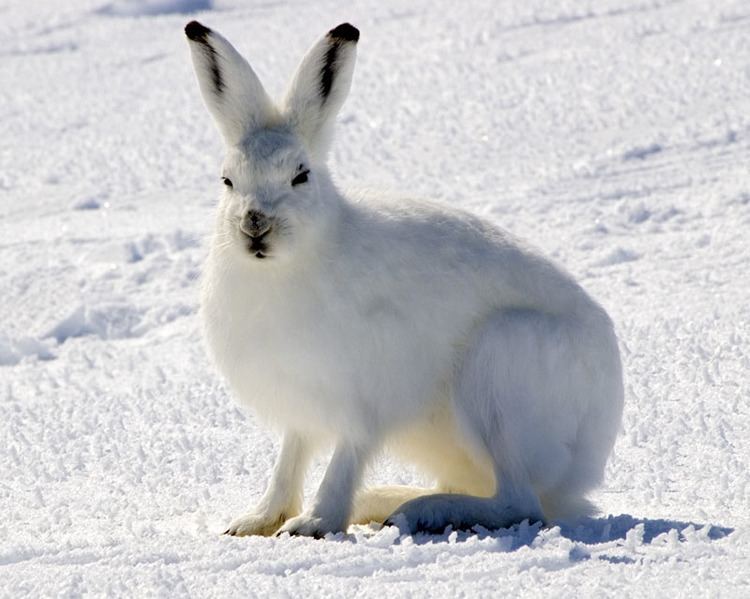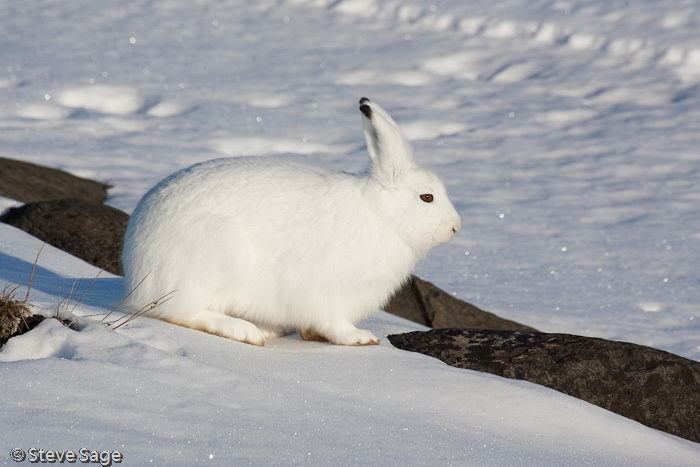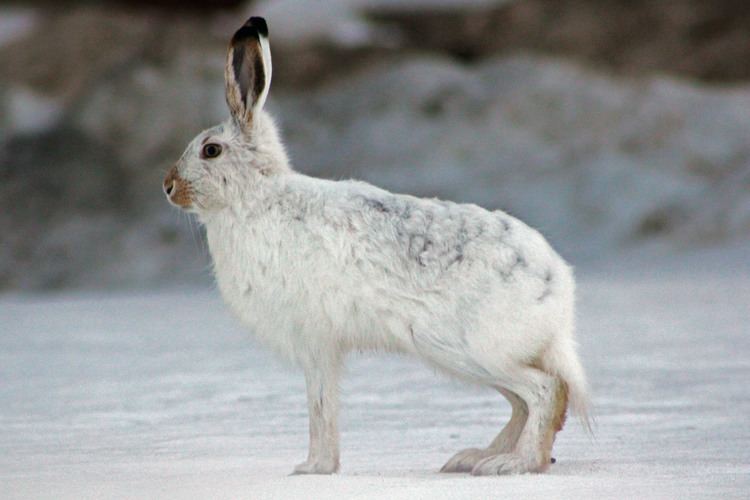Genus Lepus Scientific name Lepus arcticus Lifespan 5 years Higher classification Hare | Phylum Chordata Species L. arcticus Mass 2.5 – 7 kg (Adult) Speed 60 km/h (Maximum, Adult) | |
 | ||
Length 43 – 70 cm (Adult, Without Tail) Similar Hare, Leporids, Snowshoe hare, Arctic fox, Mountain hare | ||
Arctic hare
The Arctic hare (Lepus arcticus), or polar rabbit, is a species of hare which is highly adapted to living in the artic tundra, and other icy biomes. The Arctic hare survives with shortened ears and limbs, a small nose, body fat that makes up 20% of its body, and a thick coat of fur. It usually digs holes in the ground or under snow to keep warm and sleep. Arctic hares look like rabbits but have shorter ears, are taller when standing, and, unlike rabbits, can thrive in extreme cold. They can travel together with many other hares, sometimes huddling with dozens or more, but are usually found alone, taking, in some cases, more than one partner. The Arctic hare can run up to 60 kilometres per hour (40 mph).
Contents
- Arctic hare
- Arctic hare crossed over sea ice
- Predators
- Range and habitat
- Characteristics
- Subspecies
- References

Arctic hare crossed over sea ice
Predators

Known predators of the Arctic hare are the Arctic fox (Vulpes lagopus), red fox (Vulpes vulpes), gray wolf (Canis lupus), Canada lynx (Lynx canadensis), ermine (Mustela erminea), snowy owl (Bubo scandiacus), gyrfalcon (Falco rusticolus), rough-legged hawk (Buteo lagopus), and humans (Homo sapiens).

The Arctic wolf is probably the most successful predator of the Arctic hare, and even young wolves in their first autumn can catch adult hares. Arctic foxes and ermines, which are smaller, typically prey on young hares. Gyrfalcon carry hares to their nests, cutting them in half first; gyrfalcons use hare bones and feet in the structure of their nests on Ellesmere Island, Nunavut. Peregrine falcons (Falco peregrinus) also prey on Arctic hares in the southern end of the hares' range. The Snowy owls mainly targets young hare; the French common name of the species derives from Anglo-Saxon harfang ("hare-catcher").

Four groups of parasites have been known to use Arctic hares as a host: protozoans (Eimeria exigua, E. magna, E. perforans, and E. sculpta); nematodes (including Filaria and Oxyuris ambigua); lice (including Haemodipsus lyriocephalus and H. setoni) and fleas (including Hoplopsyllus glacialis, Euhoplopsyllus glacialis, and Megabothris groenlandicus. Fleas are more common than parasitic worms.
Range and habitat
The Arctic hare is distributed over the northernmost regions of Greenland, the Canadian arctic islands and Northern Canada, including Ellesmere Island, and further south in Labrador and Newfoundland. The Arctic hare is well-adapted to the conditions found in the tundras, plateaus and treeless coasts of this region, including cold weather and frozen precipitation. The Arctic hare may be found at elevations between 0 (sea level) and 900 m.
In Newfoundland and southern Labrador, the Arctic hare changes its coat colour, moulting and growing new fur, from brown or grey in the summer to white in the winter, like some other arctic animals including ermine and ptarmigan, enabling it to remain camouflaged as their environments change. However, the Arctic hares in the far north of Canada, where summer is very short, remain white all year round.
Characteristics
The Arctic hare is one of the largest living lagomorphs. On average, this species measures from 43 to 70 cm (17 to 28 in) long, not counting a tail length of 4.5–10 cm (1.8–3.9 in). The body mass of this species is typically between 2.5–5.5 kg (6–12 lb), though large individuals can weigh up to 7 kg (15 lb).
The Arctic hare is a herbivore, and specifically a folivore. Arctic hares feed primarily on woody plants, and willow constitutes 95 percent of their diet year-round. Arctic hares predominantly consume such as saxifrage, crowberry, and dwarf willow, but can also eat a variety of other foods, including lichens and mosses, blooms, other species' leaves, twigs and roots, mountain sorrel and macroalgae (seaweed). Arctic hare diets are more diverse in summer, but still primarily consists of willow, dryas and grasses. Arctic hare have been reported to occasionally eat meat, including fish and the stomach contents of eviscerated caribou. They eat snow to get water.
Female hares can have up to eight baby hares called leverets. The leverets stay within the mother's home range until they are old enough to survive on their own.
There is little information on the lifespan of Arctic hare. Some anecdotal evidence suggests they live three to five years in the wild. Arctic hare do not survive well in captivity, living only a year and a half at most.
Subspecies
There are four subspecies of this hare:
